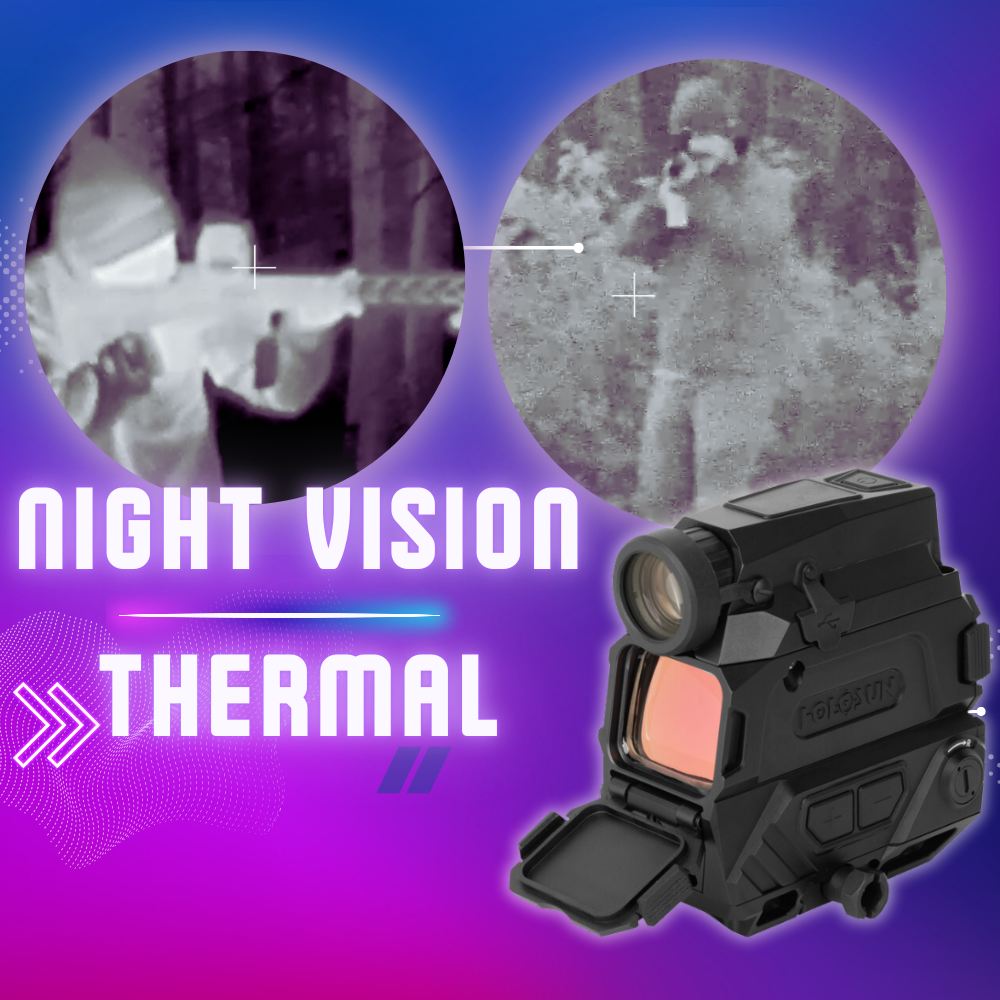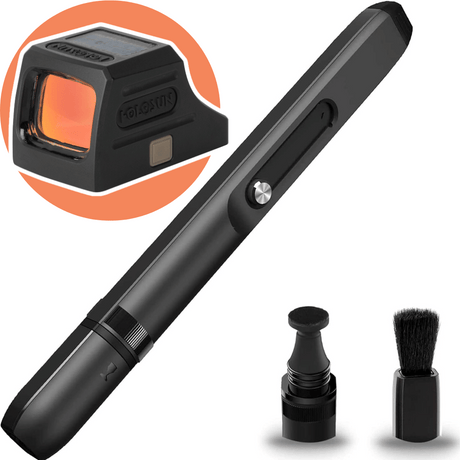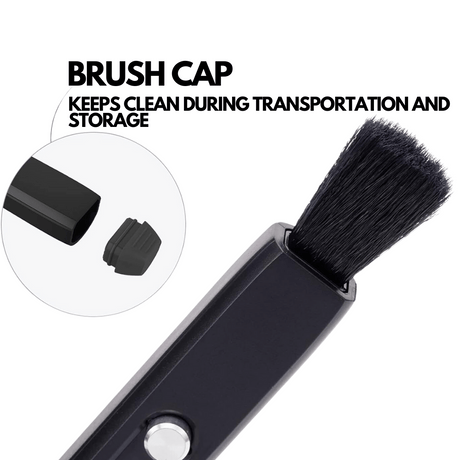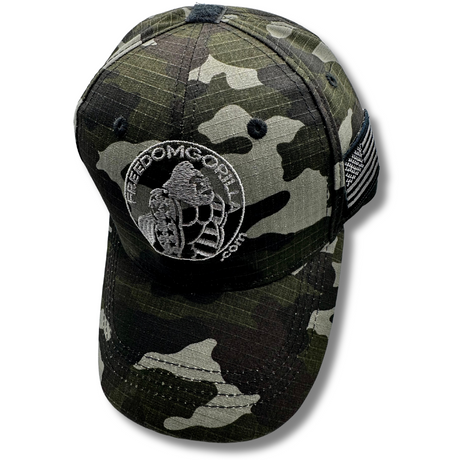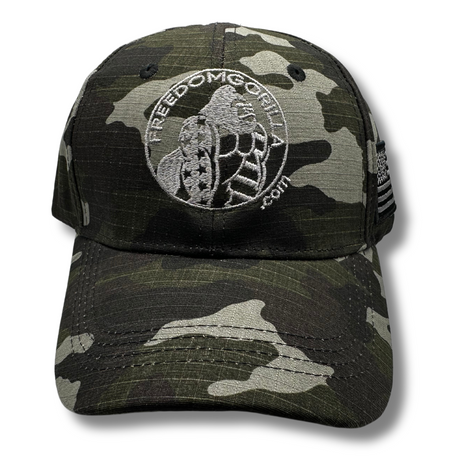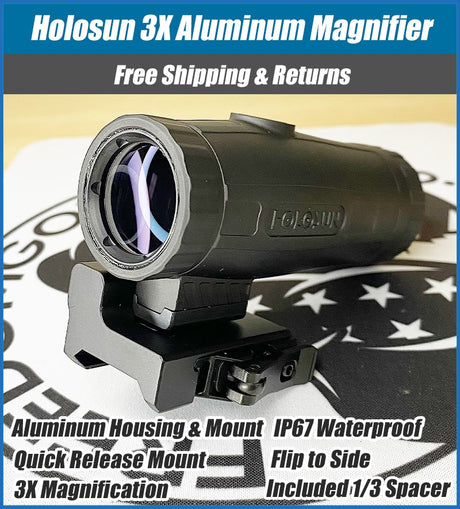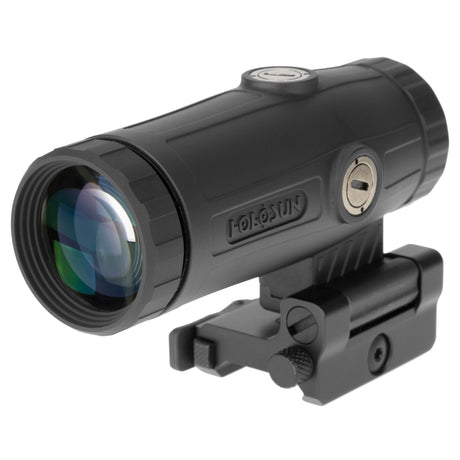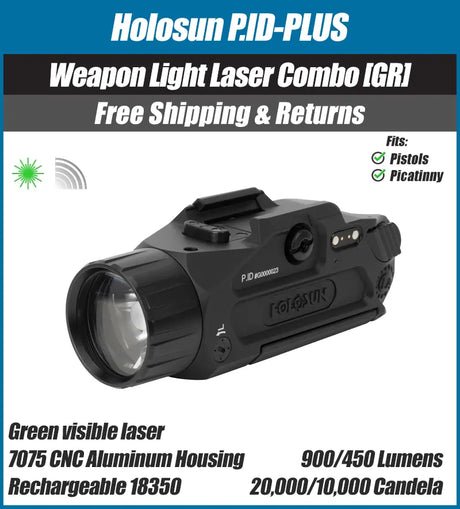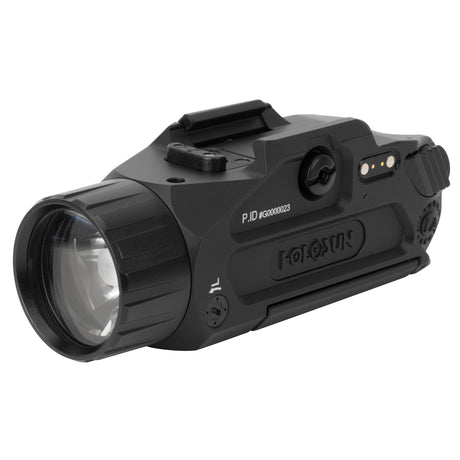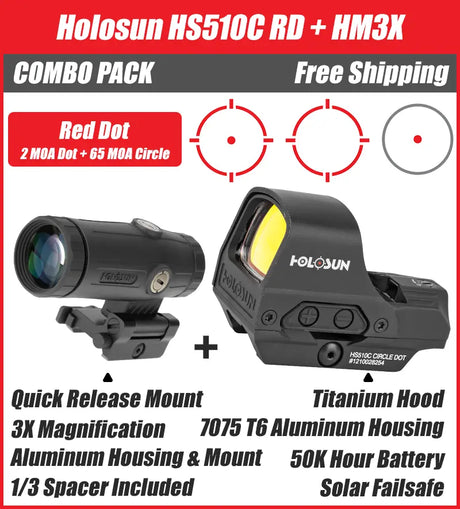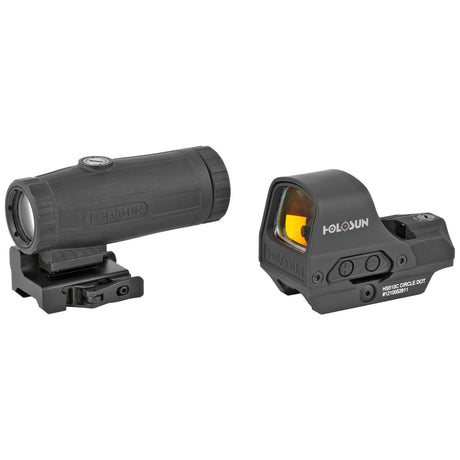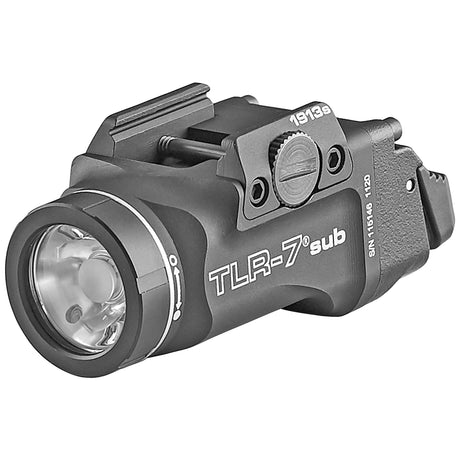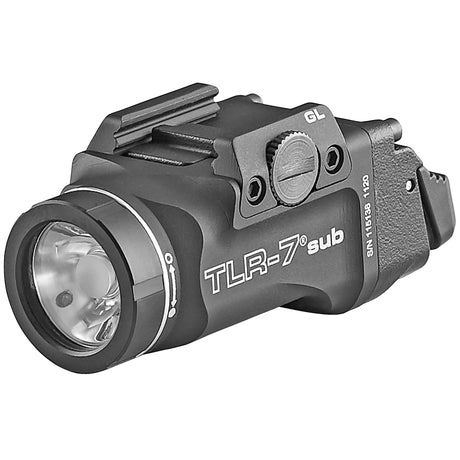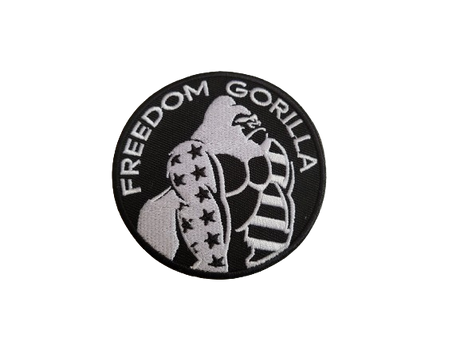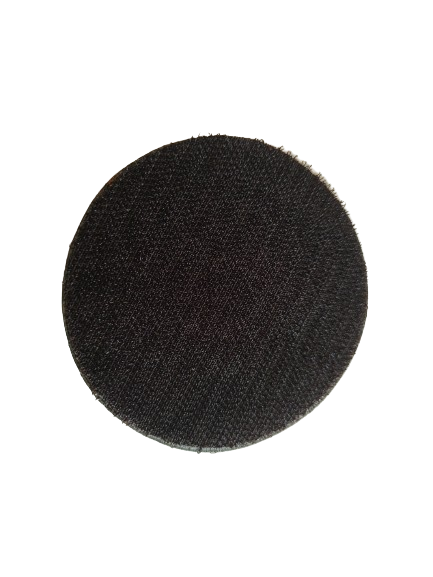Hey Freedom Gorillas! We’ve finally got our hands on the long-awaited Holosun night vision and thermal optics! I know that the manual can look a bit intimidating, and for many of you, this might be your first experience with thermal or night vision. And it definitely looks appealing, especially at this price point. So in today’s post, we’ll break down how each optic works, walk you through the buttons, test them out, and give you our honest take on both. Holosun put out a seriously advanced optic here, and we're here to make sure you know exactly how to get the most out of it!
View NV & TH Optics At The Best PriceBattery

To turn on either optic you first need to put in the included batteries. Simply open up the side tray door. Then to recharge the optic use the included charge. Both units use two 18350 rechargeable flat-top batteries.
The DRS-NV delivers up to 6 hours of runtime in full function mode and 8 hours in observation mode. The DRS-TH offers up to 10 hours of battery life for the thermal sensor. For both, the red dot can run for 50,000 hours on the same power setup, utilizing two 18350 Li-ion rechargeable batteries.
Red Dot Function:
One thing I want to highlight that is a huge pro is you don't have to have a dedicated thermal or night vision rifle, because the red dot is also a part of these optics. So you can use this like a normal red dot just like the 510C, AEMs, or other popular Holosun rifle red dot models. Which makes it easy to hit the ground running, because it’s a setup that feels familiar and straightforward.
MRS Reticle

First, let’s talk about the Multi-Reticle System on this optic. It comes with a 2 MOA dot sitting in a 65 MOA circle. By default, you’ll see the 2 MOA dot in the 65 MOA circle, but you can toggle the reticles just like any other Holosun. Just hold down the ‘-’ button for three seconds, and you can cycle through three reticles: the Circle + Dot, the Dot only, or the Circle only.
Buttons

Let’s go over the basics of operating the red dot sight on the DRS-NV, starting with the buttons. You’ll find the ‘+’ and ‘-’ buttons on the left side of the optic, and they control all the main functions. To turn on the red dot, just give either the ‘+’ or ‘-’ button a quick press. To turn it off, press both buttons at the same time, and it’ll shut off right away.
Operational Modes
Now, let’s talk about the operation modes. There are two main modes: Manual Mode and Lockout Mode. There is no auto brightness mode with either of these optics. In Manual Mode, you have control over the brightness with 12 different levels. Settings 1 through 4 are night vision compatible, and setting 12 is the brightest for daytime use. You can adjust brightness by pressing the ‘+’ to go brighter or ‘-’ to dim it down.
In Lockout Mode, the optic locks the settings to prevent accidental changes. To activate Lockout Mode, just hold down the ‘+’ button for three seconds—when the LED blinks once, you’ll know it’s in Lockout. To unlock, hold the ‘+’ button again for three seconds until you see that blink.
Shake Awake
Also one last thing I wanted to note about the red dot, both of these optics do have shake awake, which by default shuts off after 10 minutes of inactivity. You can adjust that length, we have a video covering it and I’ll link it in the description.
NV/TH Function:
Alright, let’s talk about the Night Vision and Thermal functions on this optic—this is where things get exciting! To see the full demos, check out our YouTube video below:
Turning On/Off
To get started, just remove the cap from the lens. Then, press and hold the power button at the top of the optic for about two seconds. That’ll activate the digital night vision camera, and if you need to turn it off, just hold the power button down again for another two seconds.
One thing to watch out for is the Auto Off or sleep mode. I ran into this myself and thought I’d broken the optic when it wouldn’t turn back on! Here’s the trick: if you hold the power button for five seconds, you’ll see a red light start blinking at the top. This actually puts the optic into a ‘sleep mode’ adjustment mode. If you’re stuck in this mode, don’t worry—a quick tap of the power button will bring it back to life, and you’re good to go.

Remember, if you see that red light blinking, it’s likely just in sleep mode and not broken. Simple fix, but definitely something to keep in mind!
Buttons - Tap/Hold Functions
Let’s dive into the controls! Each of the five buttons on this optic has two functions, depending on whether you tap or hold it. Let’s break them down one by one.

Magnification
First up is the Magnifier button. A simple tap will switch the view between different magnification levels, which gives you flexibility in how you view your surroundings.
The THERMAL only has a 1x, 3x, and 5x magnification. The NIGHT VISION only has 1x, 2x, 4x, and 8x magnification.
If you hold the magnifier button down, it’ll refresh the magnification sensor, which can help clear up any issues if the view looks off.
Brightness
Next, we’ve got the Brightness button—the one marked with a sun symbol. Tapping it lets you adjust through six brightness levels, so you can find the best setting for your environment.
For the THERMAL only – Holding it down unlocks a few different view modes: High Light Mode, Outline Mode, and White Hot Mode, each useful for different lighting conditions or preferences. I like White Hot mode the most and I imagine this is what most people will also like.
OK Button
The OK button is your menu control. Tap it to bring up a menu with options like Image, Calibration, and Settings.
Calibration is key here, and I’d think this is the most important screen for most users. To calibrate your thermal/NV reticle, start by zeroing your red dot first, and then use Calibration mode to align the digital reticle with the red reticle. This ensures the thermal/NV reticle lines up with your red dot for accurate targeting.
To exit the menu, just hold the OK button—it doubles as a back button.
Up Button
The Up button handles photo and video capture. Tap it, and it’ll snap a photo, capturing the view on-screen.
Hold it down, and you’ll start recording video. With 32GB of internal storage, you can record directly onto the optic and transfer the footage later.
Down Button
Finally, the Down button manages the thermal reticle, which operates independently of the red dot. Tap it to cycle through three brightness levels for the thermal reticle.
Hold it down to change the style of the thermal reticle itself, giving you even more customization.
TECHNICAL STATS

Both optics have a window size of 1.25x0.98 inches, which gives you a good amount of space to view through without making it bulky. Overall size-wise, it’s pretty compact at 3.7 x 2.2 x 3.5 inches and weighs 18.5 ounces – not too heavy at all.
The optics are rated IP67 waterproof, meaning it can handle being submerged up to a meter for 30 minutes without issues. The housing is made of 7075 T6 aluminum, a material known for its strength and resistance to corrosion, which makes it durable enough to handle rough conditions.
The night vision has a
NV VS TH
Alright, let’s talk about night vision vs. thermal for rifle scopes, two incredible tools that’ll change how you hunt, shoot, or observe in low light. Whether you're into hog hunting at night, tracking game at dawn, or just like to see what's out there, these optics offer some serious advantages, each with its unique strengths. So, let’s break it down in an easy-to-digest way.
Night Vision Scopes

Night vision scopes amplify existing light, which means they depend on moonlight, starlight, or ambient light sources to create a clear image. These scopes have that classic green tint you’ve probably seen in movies. But they can struggle if it's a pitch-black night, so many night vision scopes come with an infrared illuminator (IR) that basically shines an invisible flashlight out into the dark to give you more visibility. Holosun recommends one of their laser devices with IR Illumination such as the LE321, or LS321. Verify your local and/or state laws before attaching an IR illumination device to a firearm with a night vision device.
Practical Example: If you’re out in the woods, say, trying to spot coyotes, a night vision scope will help you pick out details like fur patterns and facial features – great for identifying animals accurately. The clarity on a night vision scope can also be perfect for close-to-mid-range scenarios, so if you're shooting around 100-150 yards, you’ll usually get a nice, detailed image.
Use Cases:
- Hunting: For animals that are sensitive to heat and might blend into their surroundings, night vision helps you see fur and physical detail in moderate low-light.
- Observation & Navigation: Night vision works well if you're maneuvering in dark areas, like scouting trails or setting up a stand in low-light hours, because it lets you see real-world details without drastically altering depth perception.
Thermal Scopes

Thermal scopes work by detecting heat. Every living creature emits heat, so thermal scopes pick up that energy, even in total darkness, rain, or fog. You’ll see the heat signature of an animal as a glowing white or dark shape, depending on your settings. With thermal, you’re not just seeing "what's out there"; you're seeing anything with body heat, even if it’s hidden in dense brush.
Practical Example: If you’re tracking a wild hog in heavy cover at night, a thermal scope will help you locate it, even if it’s tucked into the brush or blending in with the environment. Thermal doesn’t need any ambient light, so it's great for spotting critters from far distances – think 300+ yards in total darkness.
Here's a deer we saw at 30 yards:

Here's three deer we saw at 250 yards:

On video you're able to see the whole outline and it looks better, but this is just a still image. Still we were very impressed thermal was able to see that far!
Use Cases:
- Long-Range Spotting: Thermal shines in open fields or for spotting game at distance. It’ll quickly show you if something’s moving out there, especially helpful in thick or overgrown terrain.
- Finding Downed Game: After taking a shot, thermal is amazing for tracking and finding downed game by locking onto residual body heat.
- Surveillance and Search: Whether it’s for pest control or security, thermal lets you see any warm body that’s moving around, including animals or people, even if they're hiding in tall grass or behind bushes.
Key Differences
- Identification: Night vision is better if you want to see details and confirm exactly what you’re looking at. Thermal is less detailed but makes it easy to spot anything warm, even from far off.
- Range & Environment: Night vision works great in open areas with some ambient light. Thermal is ideal for spotting hidden targets in thick cover or total darkness.
- Weather Conditions: Thermal is less affected by light or weather, so it’s your go-to in fog, rain, or snow. Night vision can struggle in poor weather since it relies on light.
In short, if you’re primarily identifying animals or targets at closer range, night vision could be the way to go. But if you want something that can spot heat signatures no matter what, thermal is your friend.
When You Might Want a Night Vision Optic
- Hunting in Moderate Low-Light Conditions: If you’re going after coyotes, raccoons, or other small game right at dusk or early dawn, night vision is perfect. It’ll give you enough detail to identify the animal at close to mid-range, where most shots are taken.
- Navigating or Scouting in the Dark: Let’s say you’re moving to a hunting spot or setting up a stand before dawn. Night vision is great for navigating trails, scanning for obstacles, or checking out terrain details without needing to flip on a flashlight.
- Close Range or Dense Brush Hunts: If you’re in close-range or wooded areas, night vision helps you get that extra bit of clarity to identify your target up close and in detail. Perfect for hunting in thick forest where identifying animals is critical.
- Wildlife Observation: For anyone who enjoys observing wildlife at night, night vision helps you see animals in their natural habitat with minimal disruption. You’ll be able to see details like fur patterns, making it easier to distinguish between species.
When You Might Want a Thermal Optic
- Spotting Game in Total Darkness: If you’re hunting hogs, coyotes, or other nocturnal animals in pitch-black conditions, thermal is unbeatable. It’ll detect body heat from afar, even in zero light, helping you locate animals before they come into range.
- Finding Game Hidden in Dense Brush: Let’s say you’re tracking a deer or hog that’s hiding in tall grass, brush, or thick foliage. Thermal can pick up their heat signature through the cover, making it perfect for those dense environments.
- Long-Range Spotting: Thermal excels at detecting heat sources from hundreds of yards away, so if you’re in open fields or larger hunting grounds, you can scan a huge area and pick up any warm-bodied animals before they even get close.
- Tracking Downed Game: After a shot, thermal is excellent for tracking a wounded or downed animal by picking up residual heat. This is especially useful if the animal runs off into thick cover where it might be tough to locate with night vision alone.
- Poor Weather Conditions: If you’re hunting in fog, rain, or snow, thermal won’t be impacted like night vision might be. It’s great for spotting in adverse weather, so you can stay out even if conditions aren’t ideal.
Misconceptions
1. "Night Vision and Thermal Are the Same Thing"A lot of people think night vision and thermal are interchangeable, but they’re very different tools. Night vision amplifies existing light (even if it’s just a sliver of moonlight) to create a visible image, while thermal detects heat signatures. In other words, night vision helps you see in low-light, while thermal is more about picking up heat, even in complete darkness or through obstacles.
2. "Night Vision Works in Total Darkness"Night vision needs at least a little bit of ambient light to work, so in pitch-black conditions, it’s not as effective. That’s why many night vision scopes come with IR illuminators to boost visibility. Thermal, on the other hand, doesn’t need any light at all – it only relies on heat.
3. "Thermal Scopes Show Clear Details Like a TV Screen"People often expect thermal to show crisp, clear images like you'd see on a security camera or TV show. But in reality, thermal images are more like a glowing silhouette without fine details. It’s awesome for identifying the presence of something warm, like an animal, but it’s not great for fine details like fur color or facial features.
4. "Thermal Can See Through Walls"Nope! Thermal can detect heat, but it won’t “see” through solid objects like walls or thick vegetation. What it can do is detect residual heat from objects or animals, so if something was recently there, thermal might pick up on the heat that’s left behind. But a wall itself blocks thermal imaging from seeing what’s behind it. It also can't see through windows... we tested it. Night vision can see through windows though.
5. "Night Vision Is Only for Tactical or Military Use"Many people think night vision is only used by the military or special forces, but that’s not true anymore! Hunters, wildlife observers, and even campers now use night vision because it’s become more affordable and accessible. It’s just another tool to help you see in low light.
6. "Thermal Is Only Useful at Night"Thermal actually works 24/7 because it’s based on heat, not light. So, if you’re trying to spot something during the day that’s hidden by thick brush, thermal can be really helpful. It’s perfect for situations where visibility is tough, no matter the time of day.
7. "You Can Just Strap On Night Vision or Thermal and Be Good to Go"Both night vision and thermal take a bit of practice. With night vision, you’ve got that green or monochrome view which can take time to get used to, especially if you’re trying to judge distance. And with thermal, the lack of fine detail means you need to rely on shapes and movement to identify what you’re seeing.
8. "Thermal Scopes Are Always Better Than Night Vision"This isn’t a one-size-fits-all situation. Thermal is amazing for spotting in darkness or through fog, but if you want detail – like identifying what animal you’re looking at – night vision can often provide better clarity. Each has its pros and cons, so it really depends on what your main goal is.
Overall it's important to keep in mind that night vision and thermal aren’t magic, but very powerful tools with their own quirks.
Pros/Cons
Night Vision on a Rifle Setup
Pros
- Detailed Imaging: Night vision shows more realistic details, like fur patterns and animal shapes, making it easier to identify the specific type of animal.
- Better Depth Perception: Because it’s amplifying real-world light, night vision gives a clearer sense of depth, which is helpful for aiming and navigating.
- Wider Field of View: Night vision typically provides a broader view compared to thermal, which can feel a bit more zoomed in. This wider view helps in scanning and tracking targets.
- Affordable Options: Night vision technology has become more accessible and often costs less than thermal for similar quality levels.
Cons
- Needs Light to Work: It can’t operate in total darkness without an IR illuminator, and even with an IR, performance can drop in extreme low-light environments.
- Can Reveal Your Position: If you’re using an IR illuminator, anyone else with night vision can see it, potentially giving away your location.
- Limited Use in Weather: Night vision can struggle in fog, rain, or snow because it relies on visible light, which gets distorted in these conditions.
- Sensitive to Bright Light: If a sudden bright light appears, like someone turning on a flashlight or a vehicle driving by, it can momentarily blind the night vision and damage some models.
Thermal on a Rifle Setup
Pros
- Complete Darkness Capability: Thermal doesn’t rely on any light, so it works in total darkness without an IR illuminator.
- Easily Spots Hidden Animals: Thermal can detect animals even if they’re behind bushes, in tall grass, or partially hidden, making it ideal for dense terrain.
- Performs in All Weather Conditions: Thermal is less affected by fog, rain, or snow, so you can get reliable performance in various weather conditions.
- Longer Range Detection: Thermal can detect heat sources from hundreds of yards away, making it great for spotting game from afar before they’re close enough for night vision.
- Tracks Residual Heat: If an animal moves out of view, you can often see residual heat left on the ground or foliage, which helps with tracking.
Cons
- Less Detailed Image: Thermal gives a basic heat signature without fine detail, so it’s harder to confirm exactly what animal you’re looking at.
- Higher Cost: Thermal technology tends to be more expensive than night vision for the same quality level, which can be a factor for budget-conscious buyers.
- Learning Curve: Since you’re working with heat signatures rather than visible images, thermal takes some getting used to, especially for identification.
- Narrower Field of View: Thermal optics often have a smaller field of view compared to night vision, so scanning an area might take longer.
Final Thoughts
In summary, both the Holosun Night Vision and Thermal optics offer powerful features tailored to unique scenarios, whether you're scanning for game, tracking in dense cover, or observing in challenging light conditions. With these optics, you get the advantage of Holosun's familiar red dot alongside advanced night vision and thermal capabilities, making for an incredibly versatile setup.
No matter your preference—night vision for closer, detailed identification, or thermal for spotting heat at long range—Holosun's optics provide practical tools to level up your hunting, tracking, and nighttime observation experiences.
Ready to try one out for yourself? Everything you need is available right here at Freedom Gorilla!
| View Thermal At The Best Price | View NV At The Best Price |

